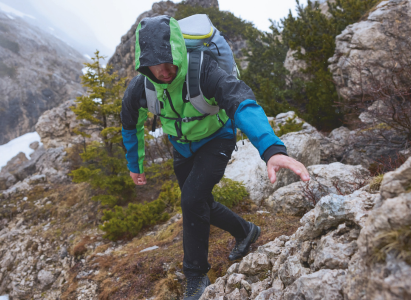
If you're planning on spending any time outdoors over the colder, darker and wetter months, then you want to be fully prepared for all the elements. Having the right waterproof sports and outerwear will really help to ensure that you're able to face rain, sleet, snow and wind.
But what makes a jacket, coat or pants waterproof? How can you tell how waterproof or breathable these pieces of clothing are?
The aim of this guide is to help explain our ARED fabric technology, how we grade and test the waterproofing and breathability and to give you the lowdown with any technical phrases.
What is a Waterproof and Breathable Fabric?
It's important to not get waterproof, water resistant and water repellent confused. Water repellent means that the piece of clothing is able to withstand some water, but not all. That means technically waterproof and water resistant clothing can be classed as water repellent. However, water resistant clothing offers lower levels of water repellency than waterproof. If you're looking to ensure you're fully protected from any wet weather, then you want waterproof outerwear. For a fabric to be waterproof, it needs to have a membrane or some form of coating that works as a barrier to prevent any moisture from getting into the fabric.
For clothes to be breathable, the fabric needs to be to able to allow water vapour to pass through. This may sound like it acts against the waterproofing properties, however the water vapour that moves through the fabric tends to be created by your own skin (sweat etc) so removing that vapour will help to keep you feeling comfortable and help to regulate body temperature.
How Do You Test Waterproofing and Breathability?
Waterproofing in clothing is tested by seeing how much pressure the ski jacket, walking pants or any form of waterproofing clothing can withstand. This pressure is then stated in mmH2o, which is the amount of water pressure in millimeters. This pressure test is also known as a hydrostatic head test. For clothing to be classed as rainproof, the rating needs to be a minimum of 5,000mm (or 5K.) This level of waterproofing will be able to protect you from a light rain shower but not much more. 10-15K rating is able to protect against heavy rain and snow but it will start to soak through after a prolonged time of being exposed to this weather. Anything with a rating of 20K and above provides incredibly high levels of protection, even in exposed situations.
If you're an avid skier, or you enjoy hikes whatever the weather, you ideally want a jacket or pants that has a minimum waterproof rating of 10K or above to ensure you're staying dry.
To ensure that a piece of clothing can be classed as fully waterproof, rather than just being made with a waterproof fabric, that garment needs to have taped seams. Critically taped seams are when only the key internal seams (hood, neck, shoulders) are taped to block water where you need the more protection. Then fully tapes seams are went all the internal seams are taped to make sure that no water can seep through, this gives the garment complete waterproof protection.
The breathability of fabric is measured by seeing how much water (by weight) can get through a square meter of the fabric in a 24 hour time frame. This number is known as the Moisture Vapour Transmission and again, similar to the waterproof rating is stated in the thousands.
5,000 - 10,000 tends to be the standard for travelling or camping, situations in which you won't be breaking a proper sweat. Then a rating of 10-15K is ideal for more strenuous activity, including backcountry skiing. Any items with a rating of 15/20K or above is suitable for really strenuous activities where you know you will be sweating a lot, or where you will be in warmer climates and need an extra layer or ventilation and body regulation.
Our ARED Products
ARED is our name for our waterproof and breathable fabric. We used our ARED fabric across our range of ski wear, hiking clothing and cycling clothing. You can see our ARED 5000 across our collection of ski gloves and mitts. ARED 5000 gives you enough protection to be classed as rain proof, and is lightweight enough to help you avoid overheating. Which is why it's recommended for our cycling layers.
Then you can find ARED 10K/10K, ARED 20K/30K and ARED 30K/30K across our ski wear and mountain range. ARED 30K/30K is one of our latest fabric innovations, and it boasts some of the highest levels of both waterproofing and breathability in all of the waterproof clothing market. This highly technical material has been created to protect you from even the harshest conditions, whether you're on the slopes or deep in the mountains.
When you're looking for your next waterproof jacket or trousers, take into account what activity you will be doing and how much rain or wet weather you might be expecting. You'll need a different level of waterproofing and breathability in your ski wear than you would in a cycling jacket. So it's worth being aware of what you will need from the waterproof clothing and buying items that are suitable for that.
